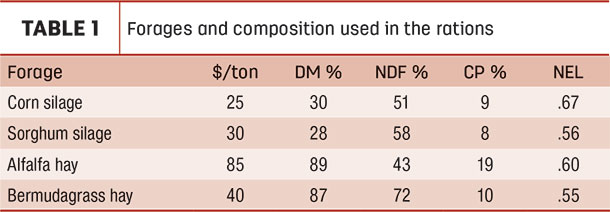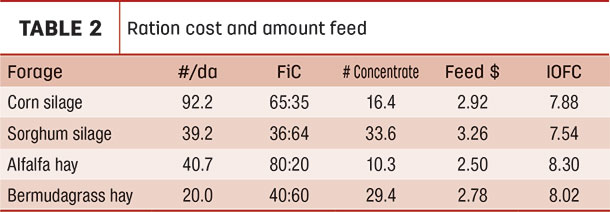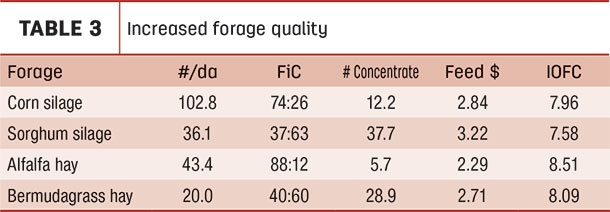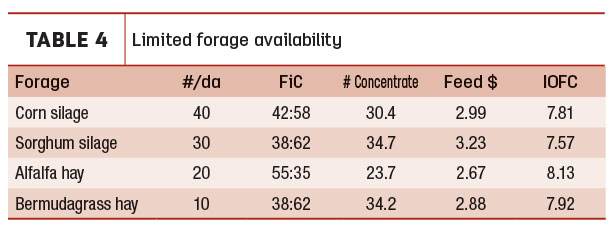Forages have always been an integral part of the feeding program for dairy cows. As a ruminant, the dairy cow needs forage in her diet. Whether forages are grazed or fed as preserved feeds, they are critical to the success of the dairy cow and the dairy farm.
With the introduction of the proximate analysis system for feed evaluation, scientific feeding of dairy cows began. The composition of feeds could be determined (crude fiber, crude protein, ether extract and minerals), and requirements for dairy cows was determined in these values.
Through the years, the system has been refined, and our cows have improved, but forages are still critical to our success.
Using corn silage, sorghum silage, alfalfa hay and bemudagrass hay, rations were calculated to show the value of forage quality and availability. Table 1 shows the composition and price of the four forages. Prices are from production budgets and do not reflect a market value. Your price can and probably will be different.

Rations were balanced for a 1,350-pound cow producing 60 pounds of 3.6%-fat milk and 155 days in milk. The price of milk is $18 per hundredweight (cwt). The concentrate mix used the amount necessary to balance the ration for each forage using the following ingredients with their prices: ground corn, $3.25 per bushel; soybean meal 48%, $285 per ton; whole cottonseed, $210 per ton; corn gluten feed, $165 per ton; soyhulls, $110 per ton; limestone, $65 per ton; dicalcium phosphate, $320 per ton; trace mineral salt, $140 per ton and Dynamate, $100 per ton. Your prices may vary from these.
Table 2 shows the rations and costs for each forage. The rations were balanced with only one forage. Forage quality of each forage was correlated with amount fed and the forage and concentrate ratio of the ration. Alfalfa hay has an advantage because of its protein content and the mix of concentrate and protein sources.

What if forage quality could be improved from the values in Table 1? If one could harvest the crop to get a 10% increase in crude protein, a 10% increase in net energy for lactation and a 10% decrease in neutral detergent fiber (NDF), how would the ration change with increased forage quality? Table 3 shows rations with increased forage quality. The result was decreased ration costs and increased income over feed cost (IOFC) for each forage. This was accomplished by increasing the forage and decreasing the concentrate, except for sorghum silage. The sorghum silage ration was cheaper because it could feed more of the cheaper grains.

Over the years in the Southeast, the amount of forage produced was limited. The full amount of forages to be fed were not available. In Table 4, rations are shown where the amount of forage was limited. For corn silage, alfalfa hay and bermudagrass hay, the amount available was approximately 50% of the first rations. Sorghum silage was only cut 20%, to maintain a minimum forage value for rumen function. With the limited amount of forage, ration cost increased as more concentrate was fed and IOFC decreased. Not only the quality of forage is critical, but the quantity of forage available is also critical.

An observation I have made over the years is that one of the indicators or signs of success in the dairy business is the availability of forage for the dairy. Farms that have more than a year’s supply can weather short crop years without paying premiums for forage and have the ability to feed different quality forage to different groups.
Forages are critical to the success of the dairy cow and the dairy farm.
This article originally appeared in the DairyFax Summer 2020 newsletter.









